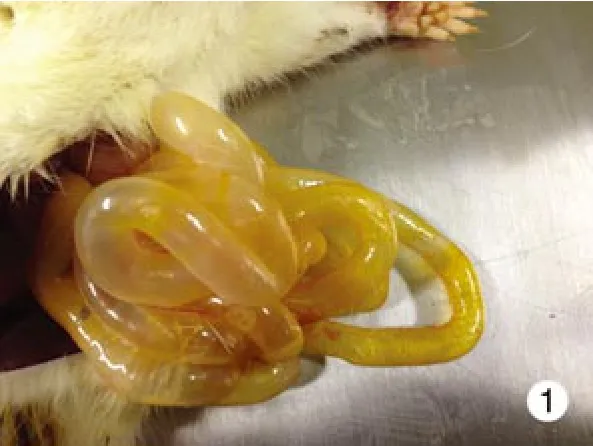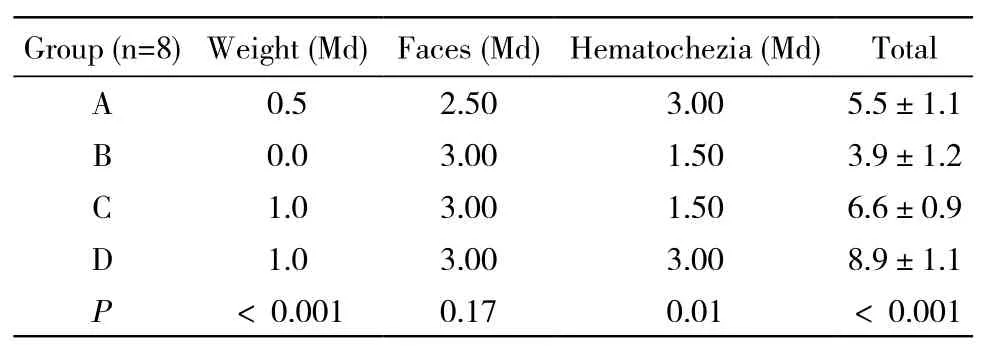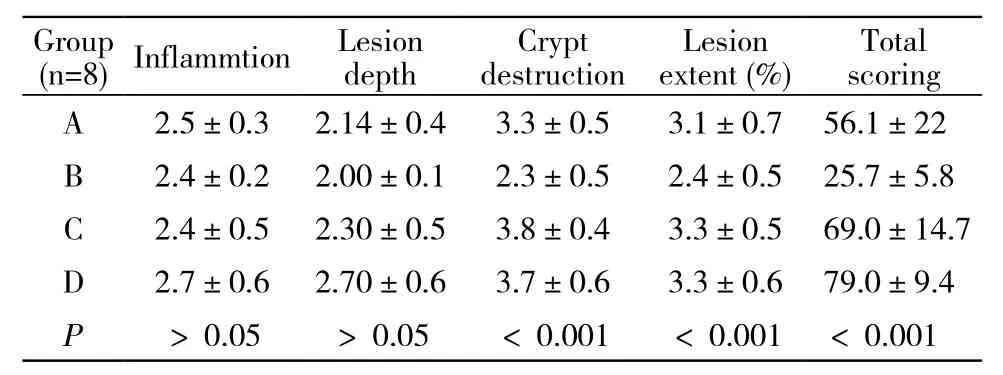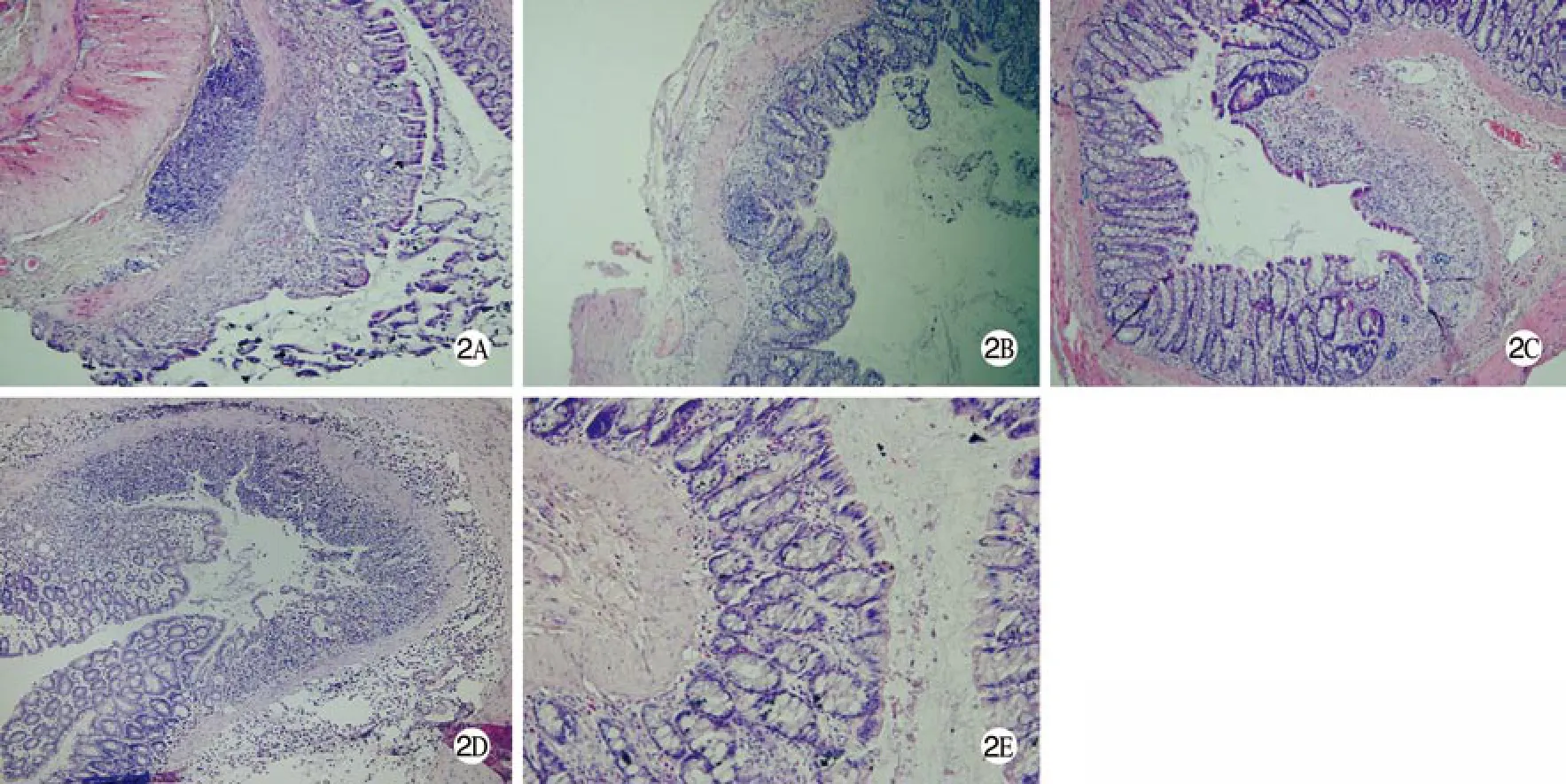不同比例ω-3/ω-6多不饱和脂肪酸对大鼠慢性结肠炎模型的影响
田玉玲,王化虹,滕贵根
北京大学第一医院 消化内科,北京 100034
不同比例ω-3/ω-6多不饱和脂肪酸对大鼠慢性结肠炎模型的影响
田玉玲,王化虹,滕贵根
北京大学第一医院 消化内科,北京 100034
目的研究不同比例ω-3/ω-6多不饱和脂肪酸对葡聚糖硫酸钠(dextran sulfate sodium,DSS)诱导大鼠慢性结肠炎的影响。方法选取40只4周龄雄性SPF级SD大鼠,随机分为A ~ E共5组。A、E组予普通饲料喂养,B、C、D组大鼠分别予ω-3/ω-6 PUFA 1∶1、1∶3及1∶30的改造饲料喂养,共6周。随后除E组外,其余4组予3% DSS水溶液自由饮用7 d后,改为普通水饮用12 d,此为1个循环。如此反复3个循环,制造慢性结肠炎动物模型。记录各组大鼠体质量、粪便、一般情况,比较各组大鼠结肠炎症状积分、组织病理损伤积分和血清及结肠组织中PGE2、LTB4、TNF-α含量。结果ω-3/ω-6 PUFA 1∶1组大鼠可以降低DSS诱导的结肠炎大鼠的炎症症状总积分(P<0.05)、组织病理损伤积分(P<0.05),血清及组织中PGE2、LTB4、血清TNF-α均有所下降(P<0.05)。ω-3/ω-6 PUFA 1∶3组部分改善DSS诱导大鼠结肠炎,使DSS诱导慢性结肠炎大鼠组织中LTB4及血清中PGE2降低。ω-3/ω-6 PUFA 1∶30使DSS诱导慢性结肠炎大鼠炎症症状积分升高(P<0.001),加重组织病理损伤积分(P<0.05),组织中TNF-α含量升高(P<0.05)。结论含有高比例ω-3/ω-6 PUFA的饲料可以改善大鼠慢性结肠炎症状,比例1∶1效果优于1∶3,饲料中过高的ω-6 PUFA可以加重大鼠慢性结肠炎。因此推测将炎症性肠病患者膳食中ω-3/ω-6 PUFA比例提高可能使患者获益。
炎症性肠病;ω-3多不饱和脂肪酸;ω-6多不饱和脂肪酸;葡聚糖硫酸钠诱导大鼠结肠炎
材料和方法
1 实验动物 雄性SPF级SD大鼠40只,4周龄,体质量93 ~ 121 g,于北京大学第一医院动物中心SPF级实验室饲养,昼夜节律12 h/12 h。购入后供应正常饲料和饮水饲养4 d,习惯环境后进行实验。本研究经北京大学第一医院实验动物福利伦理委员会审查通过。
2 饲料 基础饲料中总油脂含量为4% ~ 5%,其中ω-3 PUFA含量约1.5 g/kg,ω-6 PUFA含量约23.5 g/kg,ω-3/ω-6 PUFA比例为1∶15。向基础纯饲料按比例添加鱼油和亚麻油改造饲料,3种改造后的饲料总油脂含量均增至5% ~ 10%。其中鱼油购自海洋恒昌集团每1 g含DHA和EPA 210 mg。亚油酸购自安庆市中创生物工程有限公司,纯度为95%。ELISIA试剂盒购自北京方程生物有限公司。
3 动物分组及模型建立 40只大鼠随机分为A、B、C、D、E共5组,每组8只。A组为单纯DSS结肠炎模型组;B、C、D组为给予ω-3/ω-6 PUFA为1∶1、1∶3及1∶30的改造饲料饲养组;E组空白对照组,给予普通饲料饲养。A、E组予普通饲料,B、C、D组分别予ω-3/ω-6 PUFA 1∶1,1∶3及1∶30的改造饲料,共6周。随后A、B、C、D组大鼠给予3% DSS自由饮用诱发结肠炎。具体方案:大鼠自由饮用3% DSS水溶液7 d后,改为蒸馏水饮用12 d,此为1个循环,如此反复3个循环,制造慢性结肠炎动物模型。E组大鼠不诱发结肠炎。
4 肠标本获取 大鼠于结肠炎造模结束时予12%乌拉坦过量麻醉处死。解剖分离出全部结肠,自肛门至盲肠测量长度后,沿肠系膜缘剪开肠管,生0.9%氯化钠注射液清洗去除肠腔内容物,观察肠道病变,并留取标本。留取近端及远端病变最重处或据肛门4 cm及紧贴盲肠留取远端及近端肠道标本,经腹主动脉取血。
5 结肠炎症状评分 结肠炎模型建立开始,每天测量大鼠体质量,观察大鼠粪便性状、血便情况以及精神、毛发等一般情况。从如下3方面评价,以总分计算。1)粪便性状:0分:干球或干条形便;1分:含水分增多成型软便;2分:便松软,不成形,甚至为稀糊状便;3分:水样便。2)便血情况:0分:粪便潜血试验阴性;1分:粪便潜血试验阳性;2分:粪便上明显附着新鲜血迹,肛门口无血迹;3分:明显血便,伴肛门口大量血迹。3)体质量变化:0分:体质量增加或维持原有体质量;1分:体质量下降<5%;2分:体质量下降≥5%且<10%;3分:体质量下降≥10%。
6 结肠炎组织学评分 将标本进行苏木精-伊红(HE)染色后,在光学显微镜下观察大鼠结肠病理组织学变化。见表1。

表1 结肠组织病理炎症积分Tab. 1 Histological scoring of colon
7 炎症因子检测 将留取的结肠组织和血液使用离心机离心收集上清液。按照检测试剂盒说明书进行大鼠结肠组织和血清中前列腺素E2(prostaglandinS E2,PGE2)、白三烯B4(leukotriene B4,LTB4)、肿瘤坏死因子α(tumor necrosis factor-α,TNF-α)检测。
8 统计学处理 采用SPSS17.0统计软件,计量资料以±s表示,组间比较采用单因素方差分析或非参数检验,P<0.05为差异有统计学意义。
结果
1 炎症症状 大鼠自由饮用3% DSS诱发结肠炎,在饮用的第2天粪便开始变软,第3天粪便潜血出现阳性,第4天开始出现懒动、竖毛、毛色变差。至第5天出现肉眼可见血便,肛门附着血迹。第6天体质量开始下降。每次循环症状均较前加重。在循环间期,各组大鼠逐渐恢复。A、C、D的炎症表现明显,有大鼠出现死亡,D组1只大鼠全部肠道充气,变薄、透明,考虑巨结肠可能性大(图1)。A、B、C、D结肠炎模型各组大鼠的炎症总积分(炎症积分越高提示炎症越重),组间P<0.001 (表2)。其中D组大鼠炎症总积分显著高于其他各组大鼠(P<0.05);B组大鼠炎症总积分显著低于A组大鼠(P=0.04),C组和A组大鼠炎症总积分差异无统计学意义。
2 各组大鼠病理组织学评分 大体标本观察下E组大鼠结肠黏膜光滑,结肠炎大鼠结肠变薄,肠黏膜充血水肿明显,可见糜烂、溃疡。A、C、D组最为严重,病变主要集中在远段结肠。显微镜下观察E大鼠结肠黏膜正常;结肠炎大鼠不同程度肠上皮损伤,腺体变形,排列紊乱,甚至消失,隐窝破坏,黏膜及黏膜下层可见炎症细胞浸润,并可见淋巴小结形成(图2)。A、B、C、D各组大鼠的病理组织学评分(组间P<0.001)(表3)。A组大鼠结肠组织损伤积分显著高于B组大鼠(P=0.01);D组大鼠结肠组织损伤积分显著高于A组(P=0.02);A、C组大鼠差异无统计学意义。提示A、D组大鼠炎症较重。
3 各组大鼠炎症因子测定 A ~ E组大鼠血清中PGE2(组间P<0.001)(表4)。其中A、D组较其他组大鼠血清中PGE2显著升高(P<0.05),但A、D组间比较差异无统计学意义。B、C组大鼠血清中PGE2显著低于D组(P<0.001)(表4)。A ~ E组大鼠组织中PGE2(组间P<0.001)(表4)。其中A、C、D 3组大鼠结肠组织中PGE2较其他组显著升高(P<0.05),但3组之间差异无统计学意义。A ~ E组大鼠组织中LTB4(组间P<0.001)(表4)。其中A、D组LTB4含量显著高于其他各组(P<0.001),提示炎症较重。A、D之间差异无统计学意义。A ~ E组大鼠血清中TNF-α含量差异有统计学意义(组间P<0.001)(表4)。A、D组血清中TNF-α含量显著高于其他组(P<0.05);A、D组差异无统计学意义。各组大鼠组织中TNF-α含量差异有统计学意义(组间P<0.001)(表4)。D组大鼠组织中TNF-α显著高于其他各组,多提示炎症重于其他3组。A、B、C 3组大鼠之间差异无统计学意义。

图 1 D组大鼠巨结肠Fig.1 Megcolon of rat in group D

表2 各组大鼠炎症表现评分Tab. 2 Inflammtion severity scoring of rats in each group

表3 大鼠组织损伤病理积分Tab. 3 Histological damage scroing of rats

图 2 各组大鼠结肠组织病理HE组大鼠Fig.2 Colonic histological pathology of rats in each group Colon tissue of rats in group E was normal observed in 40 times vision by microscopy; colon of rats in colitis models showed inf l ammation with different grade, while the inf l ammation of rats in group B were lighter. The crypts were not destroyed completely, and the epithelia cells were completely relative. There were a large amount of inf l ammatory cells inf i ltrated in colon of group A, C and D, the crypt disappeared, ulcers and lymphoid nodule were formed

表4 各组大鼠血清及结肠组织中炎症因子含量Tab. 4 Inf l ammtory cytokines in colon and serum of rats in each group (ng/L)
讨论
目前IBD尚无有效治愈方法[6],且当前的治疗手段不良反应较多,花费也较大。营养支持因为其安全性,成已经为研究的新热点,其中ω-3 PUFA又成为关键点之一[7]。越来越多的证据表明,ω-3 PUFA对于炎症性疾病具有保护性作用[8-11]。很少有研究调整ω-3 PUFA和ω-6 PUFA的比例,目前对于炎症性肠病两者最佳比例也没有定论[4]。有研究发现,ω-3/ω-6 PUFA摄入比例的变化与IBD的发病有重要关系[12]。还有研究发现,与ω-3 PUFA和ω-6 PUFA的含量相比,两者的比例更能影响肠道的炎症过程[13]。DSS大鼠诱导的大鼠慢性结肠炎模型是目前化学方法诱导大鼠结肠炎模型中与人类溃疡性结肠炎最为相近的模型[14]。本研究通过设立不同比例ω-3 PUFA和ω-6 PUFA饮食,观察其对DSS诱导大鼠慢性结肠炎的症状、组织病理损伤及炎症因子的影响。
已经明确花生四烯酸-类花生酸代谢在IBD的肠道炎症致炎的关键途径。在细菌、内毒素等物质的刺激下,各种细胞膜上磷脂酶活化,动员膜上磷脂中的PUA(AA、EPA等),产生各种类型的类花生酸。类花生酸炎症过程关键的调节因子和监控因子[15]。类花生酸合成的数量和类型取决于细胞膜上AA和EPA的含量,磷脂酶A2(PLA2)、磷脂酶5-LOX和COX的活性[15-17]。来源于ω-3 PUFA诱导产生的类花生酸的活性要低于ω-6 PUFA诱导产生的类花生酸衍生物的活性。本研究中ω-3/ω-6 PUFA 1∶1组和1∶3组大鼠较DSS诱导结肠炎组大鼠血清及组织中PGE2、组织中LTB4均有下降。这与既往多数向大实验一致,向饮食或饲料中添加ω-3 PUFA可以降低花生四烯酸-类花生酸代谢途径中的PGE2和LTB4,从而减轻其介导的炎症过程。
综上所述,本实验发现饲料中ω-3/ ω-6 PUFA 1∶1,1∶3对于DSS诱导的慢性结肠炎具有改善作用,前者效果更佳;ω-3/ω-6 PUFA 1∶30加重大鼠结肠炎,可能是通过调节花生四烯酸-类花生酸代谢途径相关产物调节炎症过程。通过本研究可以推测,营养支持治疗做为一种安全有效的治疗手段应用前景巨大,增加膳食中ω-3 PUFA可能会对IBD患者的疾病具有改善作用,推荐的比例是1∶1。
1 Nell S, Suerbaum S, Josenhans C. The impact of the microbiota on the pathogenesis of IBD: lessons from mouse infection models[J]. Nat Rev Microbiol, 2010, 8(8): 564-577.
2 Hernández NB, Mañealmero J, Cortes I, et al. Role of nutrition in inflammatory bowel disease(IBD):new therapeutic approaches and recent outcomes[J]. J Nutr Ther, 2012, 1: 132-137.
3 Kappelman MD, Rifas-Shiman SL, Kleinman K, et al. The prevalence and geographic distribution of Crohn’s disease and ulcerative colitis in the United States[J]. Clin Gastroenterol Hepatol, 2007, 5(12): 1424-1429.
4 Cabré E, Mañosa M, Gassull MA. Omega-3 fatty acids and inflammatory bowel diseases - a systematic review[J]. Br J Nutr,2012, 107(S2): S240-S252.
5 Shoda R, Matsueda K, Yamato S, et al. Epidemiologic analysis of Crohn disease in Japan: increased dietary intake of n-6 polyunsaturated fatty acids and animal protein relates to the increased incidence of Crohn disease in Japan[J]. Am J Clin Nutr, 1996, 63(5): 741-745.
6 Langholz E. Current trends in inflammatory bowel disease: the natural history[J]. Therap Adv Gastroenterol, 2010, 3(2):77-86.
7 Ferguson LR. Nutrigenomics and inflammatory bowel diseases[J]. Expert Rev Clin Immunol, 2010, 6(4): 573-583.
8 Andersen V, Olsen A, Carbonnel F, et al. Diet and risk of inflammatory bowel disease[J]. Dig Liver Dis, 2012, 44(3):185-194.
9 Yates CM, Calder PC, Ed Rainger G. Pharmacology and therapeutics of omega-3 polyunsaturated fatty acids in chronic inflammatory disease[J]. Pharmacol Ther, 2014, 141(3): 272-282.
10 John S, Luben R, Shrestha SS, et al. Dietary n-3 polyunsaturated fatty acids and the aetiology of ulcerative colitis: a UK prospective cohort study[J]. Eur J Gastroenterol Hepatol, 2010, 22(5):602-606.
11 Varnalidis I, Ioannidis O, Karamanavi E, et al. Omega 3 fatty acids supplementation has an ameliorative effect in experimental ulcerative colitis despite increased colonic neutrophil infiltration[J]. Rev Esp Enferm Dig, 2011, 103(10):511-518.
12 Simopoulos AP. Evolutionary aspects of diet, the omega-6/omega-3 ratio and genetic variation: nutritional implications for chronic diseases[J]. Biomed Pharmacother, 2006, 60(9):502-507.
13 Tilley SL, Coffman TM, Koller BH. Mixed messages: modulation of inflammation and immune responses by prostaglandins and thromboxanes[J]. J Clin Invest, 2001, 108(1): 15-23.
14 Kwon HS, Oh SM, Kim JK. Glabridin, a functional compound of liquorice, attenuates colonic inflammation in mice with dextran sulphate sodium-induced colitis[J]. Clin Exp Immunol, 2008,151(1): 165-173.
15 Uchiyama K, Nakamura M, Odahara S, et al. N-3 polyunsaturated fatty acid diet therapy for patients with inflammatory bowel disease [J]. Inflamm Bowel Dis, 2010, 16(10): 1696-1707.
16 Healy DA, Wallace FA, Miles EA, et al. Effect of low-to-moderate amounts of dietary fish oil on neutrophil lipid composition and function[J]. Lipids, 2000, 35(7): 763-768.
17 Calviello G, Su HM, Weylandt KH, et al. Experimental evidence of ω-3 polyunsaturated fatty acid modulation of inflammatory cytokines and bioactive lipid mediators: their potential role in inflammatory,neurodegenerative, and neoplastic diseases[J/OL]. http://www.hindawi.com/journals/bmri/2013/743171
Effects of different ratios of ω-3/ω-6 polyunsaturated fatty acids on chronic colitis in rats
TIAN Yu-ling, WANG Hua-hong, TENG Gui-gen
Department of Gastroenterology, Peking University First Hospital, Beijing 100034, China
WANG Hua-hong. Email: wanghuahong@medmail.com.cn
ObjectiveTo investigate the effect of different ratios of ω-3/ω-6 polyunsaturated fatty acids (PUFA) on colitis induced by dextran sulfate sodium (DSS) in rats.MethodsForty male SD rats were randomly divided into fi ve groups (n=8). Group A: pure DSS induced colitis with normal diets; group B, group C and group D: diets of ω-3/ω-6 PUFA with the ratio of 1∶1, 1∶3 and 1∶30; Group E: normal controlled group. After six weeks of different diets, colitis were induced by drinking the 3% DSS freely for 7 days, and then drinking water for 12 days in all groups except of group E. The phase above was recycled by twice, and the chronic colitis rats model were established. All the rats were sacrif i ced when the last cycle was done. Inf l ammatory severity scoring and histological damage scoring were evaluated. And the level of PGE2, LTB4, TNF-α in serum and colon were measured using ELISA.ResultsThe overall inf l ammatory severity scoring of DSS induced colitis (P<0.05), histological damage scoring (P<0.05) were lowered and the PGE2in colon and serum, LTB4in colon and TNF-α in serum (P<0.05) were lessened in rats of group ω-3/ω-6 PUFA 1∶1. The imf l ammation of colitis was improved in some aspects and the LTB4in colon and PGE2in serum (P<0.05) were decreased in rats of group ω-3/ω-6 PUFA1∶3. The colitis was deteriorated and the inf l ammatory severity scoring (P<0.05), histological damage scoring (P<0.05) and TNF-α in colon were increased (P<0.05) in rats of group ω-3/ω-6 PUFA 1∶30.ConclusionDiets of high ratio of ω-3 to ω-6 PUFA improves the chronic colitis of rats, and the eff i ciency of the ratio of 1∶1 is better than 1∶3. However, high ratio of ω-6 PUFA (1∶30) deteriorates the colitis induced by DSS. It suggests that high ratio of ω-3 to ω-6 PUFA can improve the condition of patients with inf l ammtory bowel disease.
inf l ammatory bowel disease; ω-3 polyunsaturated fatty acid; ω-6 polyunsaturated fatty acid; dextran sulfate sodium induced acute colitis
R 151
A
2095-5227(2014)12-1249-05
10.3969/j.issn.2095-5227.2014.12.020
时间:2014-08-08 10:08
http://www.cnki.net/kcms/detail/11.3275.R.20140808.1008.003.html
炎症性肠病(inflammtory bowel disease,IBD)的发病机制尚不明确,大多数学者认为遗传易感染人群,在环境因素诱发作用下,对肠道菌群产生的免疫异常反应是导致IBD发病的综合机制[1-2]。既往西方国家是IBD高发的地区[3]。近年来亚洲人群的发病率快速升高,流行病学调查提示可能和西方化的生活方式传播相关[3-4]。“西方化饮食”是指高糖份、高油脂和高动物蛋白的饮食。近年来饮食中脂肪成分多不饱和脂肪酸(polyunsaturated fatty acid,PUFA)的构成发生了明显的改变。ω-3 PUFA与ω-6 PUFA的摄入比例从20世纪70年代的1∶1变为20世纪90年代的1∶15 ~ 20[5]。目前关于不同比例ω-3 PUFA与ω-6 PUFA对于炎症性肠病影响的研究比较少。本研究通过研究不同比例ω-3 PUFA与ω-6 PUFA对于DSS诱导大鼠结肠炎模型的影响,观察ω-3 PUFA对于结肠炎症的作用,试图得出一个合适的ω-3 PUFA与ω-6 PUFA比例,希望对炎症性肠病患者提供合理的营养支持指导。
2014-06-13
田玉玲,女,在读博士。研究方向:炎症性肠病。Email: yulingtian1986@163.com
王化虹。Email: wanghuahong@medmail.com.cn

